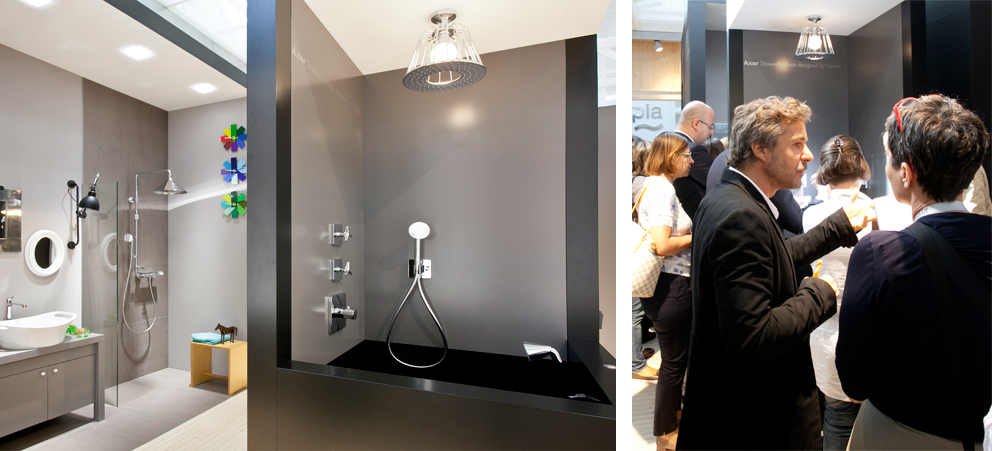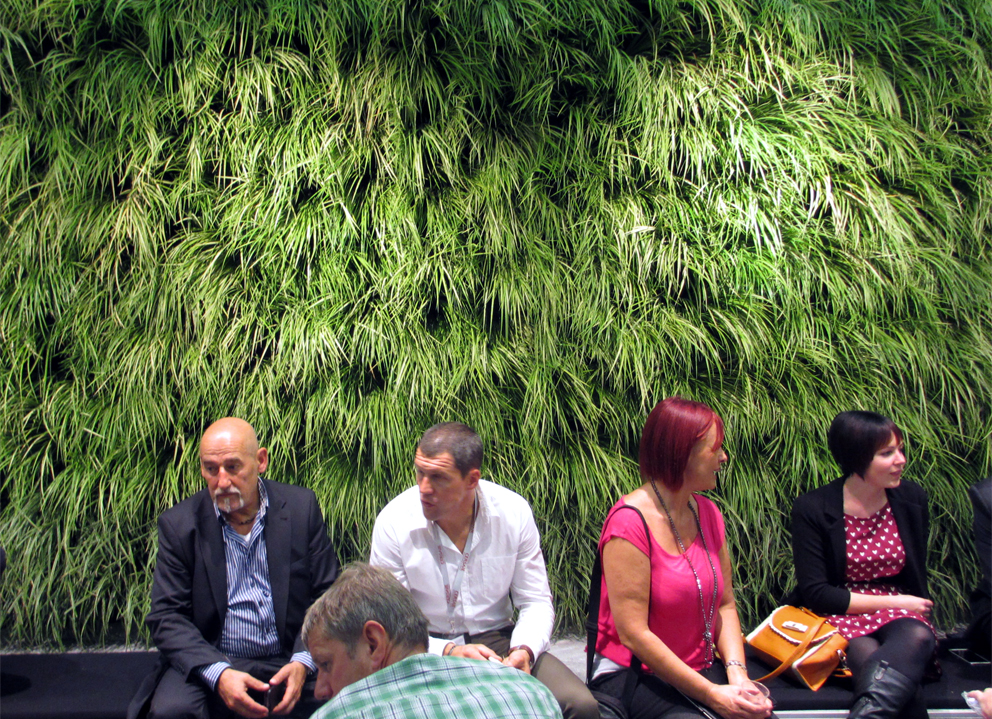
You feel nervous, even agitated and restless? Then simply close your eyes and imagine where you would choose to relax in everyday life. Where is it that you find room to breathe, to linger in peace? Where would you retreat to every now and again to leave all your cares behind? Your living room at home? Outside in the garden? No, far from it. It’s the bathroom, or at least that’s the theory of the numerous manufacturers who present their latest products at “Cersaie” in Bologna. For the ceramics industry, the bathroom has long been far more than a functional room for hygiene and cleanliness. Some manufacturers, therefore – such as “Eurorama”, “Bellosta” or “Pecchioli” – set up stands and showrooms that are like their own little microcosms, in which light, organic forms and sprayed mists of water create a secretive atmosphere, even if, in the most precise terms, it is nothing but a combination of the latest technology, lighting and ceramics that makes such artistic, feel-good zones possible.
Floral patterns on the wall
Where’s the bathroom please? This might be a question some visitors will ask themselves, given the uninterrupted trend towards “wellness zones”, even when they’re right in the middle of one. Antonio Lupi, for example, presents a bathroom wall which, with the help of the latest print technology, can be printed with any motif imaginable and is, at the same time, water repellent. Floral patterns in tasteful, rich colors give the impression that it is wallpaper that gives the room depth and a homely atmosphere.
That’s not all though: Reddish-green light seeps out of hidden cracks in organically shaped fittings (which were already a familiar sight from this year’s ISH in Frankfurt), bathing the room and ceramics in a secretive light. An inviting fire flickers in a stove, while the bathtub substructure functions simultaneously as a shelf for books and other home accessories. Hygiene articles, on the other hand, are carefully hidden behind barely visible hatches in the wall – ultimately nothing should disrupt the impression of homeliness. Furthermore, this year too themes like “energy efficiency” and the economical use of ecologically compatible materials are at the forefront – an aspect that is important to almost all manufacturers. In this vein, another innovation is a minimalist heater made of recycled aluminum, which ensures a pleasant temperature in the bathroom.
Water from the lampshade
At “Axor” too, the designer brand by “Hansgrohe SE”, there is an emphasis on ecological awareness and the reinterpretation of the bathroom. The basin mixer from the “Starck Organic” series presented in spring last year was consciously designed to save as much water as possible. In general, as far as design is concerned, manufacturers are treading new paths. Thus the “Axor WaterDream” shower series was born from a concept that was interpreted by two design agencies in entirely different ways. Trade fair visitors are nothing less than astounded when they see water flowing from a lampshade and switch on a light bulb to illuminate the fine spray mist in soft light. The shower lamp, designed by Oki Sato, the creative mind behind the “Nendo” design studio, can, if preferred, be used not only in the bathroom, but also as a light-emitting water installation in the living room. This results in a blurring of the lines between functional sanitation appliances and the cozy home ambiance.
In contrast Sofia Lagerkvist, Charlotte von der Lancken and Anna Lindgren, the Swedish designers of “Front”, present their version of the “watery dream” as an artistically arranged mesh of copper pipes, fittings, vents and funnel-shaped shower heads. Their interpretation reveals sanitation structures that are otherwise carefully hidden behind bathroom walls, but now come to the fore as both a functional and an aesthetic design element.
Creating art and saving resources
So which trends are emerging among tile manufacturers? The “Ceramics of Italy” association at least, the trademark of the Italian ceramics industry and promoter of selected companies, promised pioneering innovations and new products at the opening of the exhibition. In the run-up to the show special cultural projects were initiated with the focus on “water”, realized in collaboration with the universities of Bologna, Rome and Venice. For months on end, designers, architects and students beavered away, working on a concept for how water can be placed in a new context in relation to saving resources and in interaction with new materials.
The results were presented in various displays at the fair, but also as part of the “Bologna Water Design” exhibition. In the picturesque yet somewhat morbid ambiance of a former hospital, the “Ex Ospedale dei Bastardini”, Daniel Libeskind, Simona Marta Favrin, Nicola Moretti and Ludovico Lombardo presented their artistic designs. In one instance, grotesque sculptures made of black stone writhe in illuminated basins of water, while the high ceilings and walls of the building transport the noise of the sound installations through the space at recurring intervals. In another, canvases and video monitors lodged in buckets of water display parched faces and keywords on the theme of water scarcity.
Another room is almost entirely flooded with water – only a narrow walkway takes people to the other side of the room, where showers fill the air with illuminated mist. In the inner courtyard of the building complex, New York’s star architect Daniel Libeskind has erected an eight-meter-high sculpture – two vertical façade panels made of metal-refined ceramic rise towards one another, their postmodern formal language contrasting with their rather picturesque surroundings. As regards the visualization of a complex theme, the exhibition can be considered a resounding success.
A touch of opulence makes a welcome return
Yet are such visions also linked to the products that were exhibited at Cersaie? Do they give rise to new, future-oriented products or does the word “innovation”, much heard during these few days, fade like an echo after the end of the show? Anyone taking a look around the exhibition could find no small number of manufacturers – for example “Giulini”, “Cerdomus” or “Leonardo Ceramica” – attempting to triumph over one another by offering a particularly opulent ceramic design in a Baroque style, or sophisticated surfaces and tiles in ever larger formats. That cannot really be considered surprising, though. The pressure to present something new every year is enormous – at the end of the day, for architects, retailers and industry insiders Cersaie is an important indicator of which products could supplement the existing range. Even if, in many cases, it is more about variations of well-known tiles. Indeed, some products were also exhibited in the spring at the ISH in Frankfurt, and have simply been given a new look with new colors, forms or sizes.
One trend that emerged – probably due to the pressure to constantly have to produce something new – is the further development of print technology, with which all conceivable patterns and decors can be printed on ceramic surfaces. In line with the idea of things being “more shine than substance”, numerous variations of textile, glass, wood and laminate imitations have emerged, which allow the material to take a step back to make room for the visual effect.
Groundbreaking innovations cannot be expected year after year. The nature of the material means the possibilities are limited. Nonetheless, in 2013 Cersaie once again proved itself to be a driving force for thinking about not only new forms and decoration, but also changed functions and technologies in the bathroom. Sometimes even just a variation on the tried and tested appears surprising and new. It is for this reason that the spirit of innovation floats not only in the water, but also around the entire exhibition site.
An overview of "Ceramics of Italy" curated by Stylepark you will find here.
More on STYLEPARK:
A thousand possible worlds of water: The noticeable trend at the ISH 2013 alongside wellness is health
(18 March 2013)
Tailor-made tiling: Thomas Wagner spoke to Jacqueline Bauer and Heike Koltes from Villeroy & Boch Fliesen about the world of possibilities at the Artefactur
(11 July 2012)




















